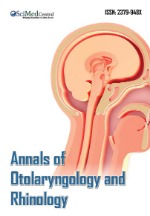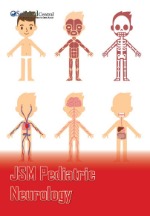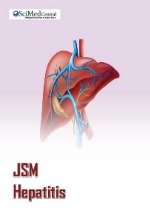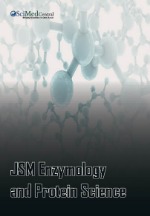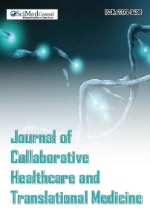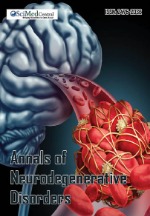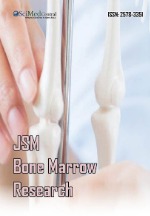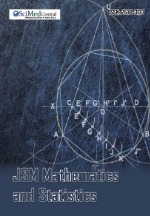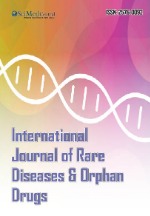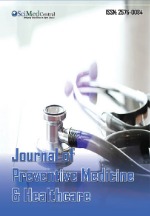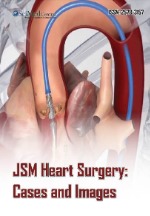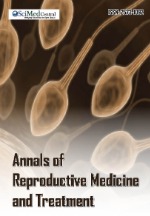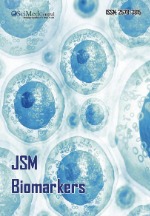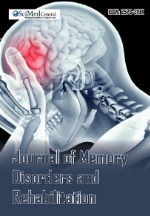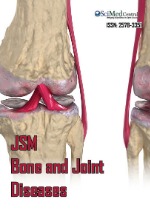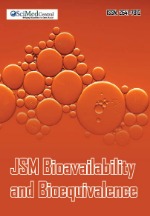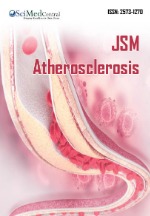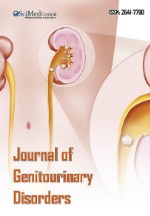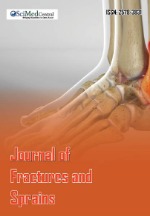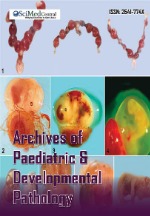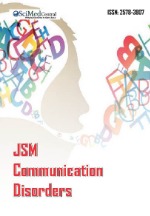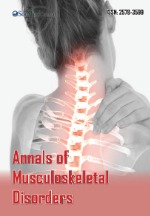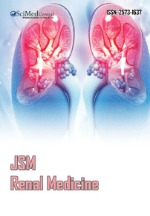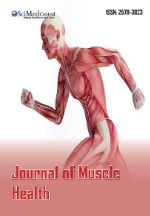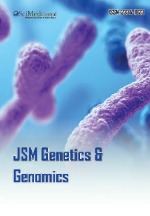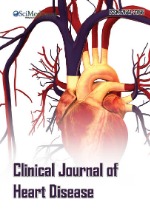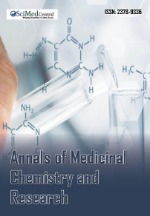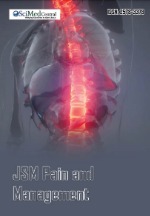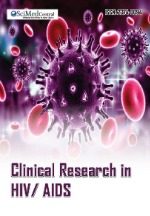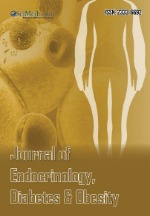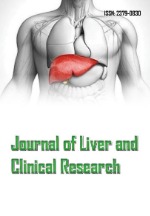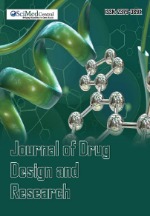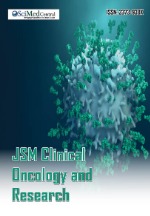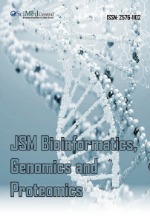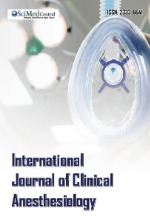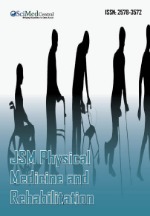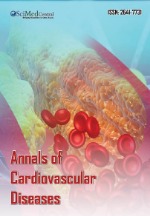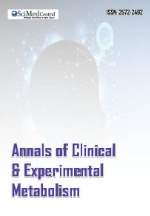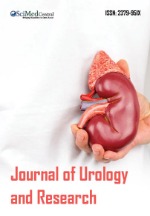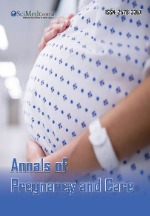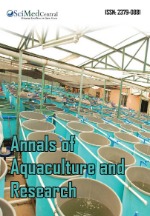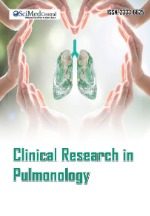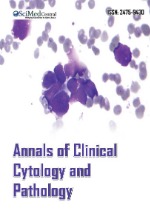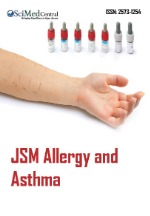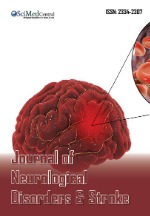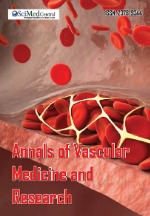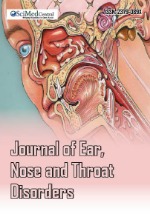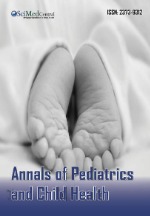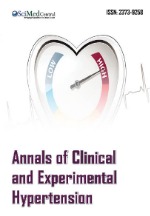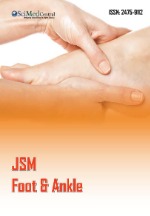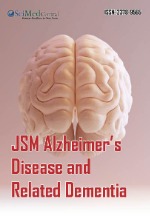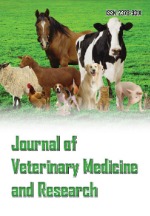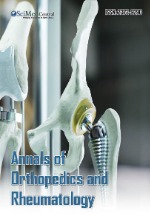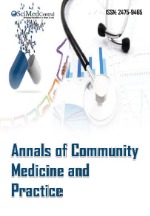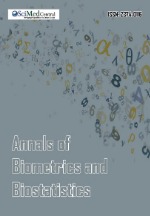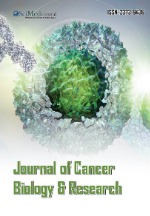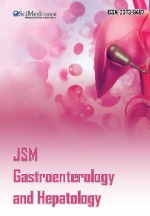Prevalence, Factors Associated and Outcome of Anaemia with Hyperferritinemia among Hemodialysis Patients in Cameroon at the Douala General Hospital
- 1. Faculty of Medicine and Biomedical Sciences of Yaoundé, Cameroon
- 2. Douala General Hospital, Cameroon
- 3. Faculty of Medicine and Pharmaceutical Sciences of Douala, Cameroon
- 4. Gyneco-Obstetric and Pediatric Hospital of Douala, Cameroon
Abstract
Background: Data on anemia with hyperferritinemia in hemodialysis patients are scarce in Sub-Saharan Africa. We aimed to investigate the prevalence, the associated factors and the outcome of anemia with hyperferritinemia in a hemodialysis patients at Douala General Hospital (DGH).
Methods: We conducted an analytical study at DGH among chronic hemodialysis patients from 1st January to 31st May 2023. Anemia was defined as a hemoglobin level <12 g/dl in females and 13 g/dl in males, and hyperferritinemia as a serum ferritin>500 ng/ml. Patients were then followed for 1 year, and death and major cardiovascular events were recorded. The data were analyzed via Excel 2019 and SPSS v20 software. Significant values were defined by p<0.05.
Results: A total of 100 participants were included, and the average age was 45.9 years ± 14.89 years. The median vintage in hemodialysis was 4 [1.12–6.75] years, and the median number of blood bags transfused per month was 3 [2–4] bags. The median ferritin level was 573.85 [533.56–631.07] ng/ml. The prevalence of anemia with hyperferritinemia (AH) was 60%. In the multivariate analysis, only the number of blood bags transfused <3bags (OR=0.18[0.06–0.55]; p=0.003) was significantly associated with AH. The mortality rate combined with major cardiovascular events was greater in AH patients than those without hyperferritinemia (36.7%, n=22; 12.5%, n=5; p=0.007).
Conclusion: Anemia with hyperferritinemia is common in chronic hemodialysis patients and is linked mainly to polytransfusion in our context. It also seems to be associated to increase mortality and major cardiovascular events.
KEYWORDS
- Anemia
- Hyperferritinemia
- Hemodialysis
- Polytransfusion
- Death and cardiovascular event
CITATION
Menye epse Ebana HDF, De Ngaha TSD, Nda Mefo’o JP, Nasser A, Kingue Epse Tatnou PD, et al. (2024) Prevalence, Factors Associated and Outcome of Anaemia with Hyperferritinemia among Hemodialysis Patients in Cameroon at the Douala General Hospital. J Clin Nephrol Res 11(2): 1124.
INTRODUCTION
Chronic kidney disease (CKD) constitutes a major public health problem due to its prevalence and high morbidity and mortality. Its prevalence is estimated at approximately 10% of the world’s population, with more than 800 million individuals. It is a heavy burden in low- and middle-income countries, which are the least equipped to address its consequences, thus becoming the 3rd cause of death in the world. This high morbidity and mortality are linked to complications of CKD, including cardiovascular disease, inflammation and anemia [1-3].
Anemia is a common complication of CKD, and its frequency increases with the severity of the disease. At the end stage, almost all CKD patients have anemia. The mechanism of this anemia is multifaceted and includes decreased erythropoietin production, iron deficiency, inflammation and blood loss, especially in hemodialysis patients. Its management includes recombinant erythropoiesis-stimulating agent (ESA) as well as intravenous (IV) iron and blood transfusion. In low-income countries, blood transfusion is still the main treatment for anemia, and IV iron is sometimes used without ESA; both can lead to hyperferritinemia with iron overload. Hyperferritinemia, especially between 500 and 2000 ng/ml, can also be linked to non-Fe-related conditions such as inflammation, malnutrition, liver disease, infection or malignancy [4]. In Tunisia, Soumara et al., reported that the prevalence of hyperferritinemia in hemodialysis patients was 58%, and hyperferritinemia was linked mainly to IV iron supplementation, liver disease and inflammation [5]. In Benin, Agboton et al., found that 67% of hemodialysis patients had hyperferritinemia, and most of them were on IV iron supplementation and ESA [6]. In Iran, Malaki reported a prevalence of hyperferritinemia of 68.35%, and hyperferritinemia was more common among patients with low hemoglobin levels [7]. Anemia with hyperferritinemia (AH) seems to be a nonexceptional situation in hemodialysis patients since inflammation is common [8,9]. This condition is usually associated with functional iron deficiency since inflammation is associated with an increased level of hepcidin, which reduces the ability to mobilize iron stores for erythropoiesis [8]. AH may also be associated to increase all-cause mortality and cardiovascular events [10,11]. However, few studies have focused on AH in hemodialysis patients, especially in sub-Saharan Africa, where hyperferritinemia is reported to be prevalent. We aimed to evaluate the frequency of AH and to determine its associated factors as well as its outcome in one of the main hemodialysis facilities in Cameroon.
MATERIALS AND METHODS
Type, location and period of the study: This is an analytic study that took place from 1st January 2023 to 30th June 2024 in the hemodialysis unit and the clinical biology laboratory of the Douala General Hospital (DGH). The DGH is a tertiary health facility located in the economic capital of Cameroon. It has 320 beds with a well-equipped laboratory, a blood bank, and radiology services. It is a nephrology reference center in the region, and the hemodialysis facility is the oldest and largest in the country.
Population studied and sample size: The target population consisted of chronic hemodialysis patients admitted to the hemodialysis facility of the DGH. Sampling was consecutive and not exhaustive, with a minimum sample size of 60 patients. All patients who were on chronic hemodialysis for more than 3 months, were aged over 18 years, gave their consent, without intercurrent pathology and were not hospitalized during the last 4 weeks were included from 1st January to 31st May 2023. Patients with known hemochromatosis or active infection, inflammatory disease or a hemoglobin level > 12 g/dl in females or >13 g/dl in males were excluded. Patients were divided into 2 groups according to their serum ferritin levels: anemia with hyperferritinemia (AH) and anemia without hyperferritinemia (AwH), and the data were compared between the two groups. Patients were then followed for a period of 12 months to evaluate outcomes.
Study variables
Patients were interviewed after providing informed consent, and data were collected via a questionnaire. The questionnaire was completed from the medical files.
We were interested in the following:
- Sociodemographic data: Age, sex, marital status, level of education, and occupation.
- Clinical data: comorbidities (hypertension, diabetes, heart failure, viral hepatitis B and C, HIV infection), duration of CKD, duration of dialysis, etiology of CKD, type of vascular access, and antianemic treatments (erythropoietin, parenteral iron supplementation, red cells concentrates transfusion) were collected.
- Biological data included full blood count, C-reactive protein (CRP), serum ferritin, and serum iron.
- Deaths, as well as major cardiovascular events (stroke, myocardial infarction, heart failure), were recorded to compare outcomes between the 2 groups.
Procedures Preanalytical procedure
Blood samples were taken at the start of dialysis, before connection to the generator, via the arteriovenous fistula after rigorous asepsis with betadine. We collected approximately 5 ml of venous blood in a tube without anticoagulant for serum iron, ferritin and CRP and 5 ml in an EDTA tube for full blood count in the hematology unit. The samples were then taken to the laboratory. The samples from the dry tube were centrifuged at 3500 rpm for 5 min and aliquoted (1000 µl of serum in cryotubes). The serum was stored at 2–8°C in a freezer for serum iron and ferritin for six days, and CRP was measured immediately.
Sample analysis procedure
Hemogram: The automated URIT 3000Plus was used, the principle of which is based on impedancemetry combined to colorimetry method.
Serum C-reactive protein: The latex slide agglutination test for the qualitative and semiquantitative determination of C-reactive protein (CRP) was used. CRP values ≤ 6 mg/L were considered negative.
Serum ferritin: An ELISA was used for determination of ferritin.
Serum iron: The colorimetric method on the Biotechnica 1500 device was carried out for the determination of serum iron. The normal values range between 0.59 and 1.58 mg/l.
The following definitions were used:
- Anemia: Hemoglobin level <12 g/dl in females and <13 g/dl in males
- Hyperferritinemia: Serum ferritin ≥ 500 ng/l.
- Severe anemia: Hemoglobin ≤ 7.9 g/dl
- Hypochromia anemia: Mean corpuscular hemoglobin concentration (MCHC) <27picogram
- Microcytic anemia: Mean corpuscular volume (MCV) was between 80 and 100 femtolitres.
- Leucopenia was defined as a white blood cell count < 4 G/l.
- Thrombocytopenia: Number of platelets < 150 G/l.
- Inflammation: CRP level > 6 mg/l or neutrophil/ lymphocyte ratio>3
- Hyposideremia: Serum iron level < 0.590 mg/L
- Hypersideremia: Serum iron level > 1.58 mg/L
Ethical considerations
We obtained approval from the ethics and institutional committee of the University of Douala as well as research authorization from the Director General of the Douala General Hospital (DGH). Written consent was obtained from all participants. The study was carried out in strict compliance with ethical rules, particularly data confidentiality and respect for the privacy of participants. The results of the examinations were communicated to the participants and treating physicians.
Statistical analysis
The statistical analysis of the data (sociodemographic, clinical and biological) was carried out via SPSS software (Statistical Package for the Social Sciences) version 20. The data were first entered into a spreadsheet in Excel 2019 software before being exported and analyzed via SPSS software. Sociodemographic and biological parameters were analyzed using means with standard deviations for continuous variables. Frequencies and percentages were used for categorical variables. One-way ANOVA was used to compare means (with standard deviations) for continuous variables. For categorical variables, we used the chi-square (Ki2) test to compare means and frequencies in the two groups. Logistic regression was used to search for univariate and multivariate associated factors. The p-value was <0.05.
RESULTS
A total of 100 patients were included, with a mean age of 45.9±14.84 years, and 56% (n=56) were male. Sixty percent of patients (60%) had AH. AH patients were older than those without hyperferritinemia were (48.65±15.03 vs 41.9±13.75 years, p=0.025). Hypertension was the main comorbidity (93%, n=93). The use of phytotherapy was common (62%, n=62), and its use was similar in both patients (60% vs 65%, p=0.65) [Table 1].
Table 1: Comparison of sociodemographic and clinical data according to the type of participants
|
Variables |
Total (N=100) |
AH (n=60) |
AwH (n=40) |
p-value |
|
Sex (Male) |
56(56) |
32(53,3) |
24(60) |
0.32 |
|
Age (years) |
45.95±14.84 |
48.65±15.03 |
41.90±13.75 |
0.025 |
|
Marital status (Married) |
57(57) |
41(68,3) |
16(40) |
0.005 |
|
Level of education (Secondary) |
59(59) |
37(61,7) |
22(55) |
0.67 |
|
Unemployed |
40(40) |
25(41,7) |
15(37.5) |
0.21 |
|
Personal care |
61(61) |
35(58,3) |
26(65) |
0.32 |
|
Hypertension |
93(93) |
58(96.6) |
35(87.5) |
0.08 |
|
Diabetes |
16(16) |
12(20) |
4(10) |
0.14 |
|
Heart failure |
12(12) |
7(11.7) |
5(12.5) |
0.56 |
|
HVB / HVC |
9(9) |
5(8.3) |
4(10) |
0.52 |
|
HIV |
8(8) |
4(6.7) |
4(10) |
0.40 |
|
Phytotherapy |
62(62) |
36(60) |
26(65) |
0.38 |
*median [Interquartile 25TH – 75th]; AH=anemia with hyperferritinemia, AwH=anemia without hyperferritinemia, HBV = hepatitis B virus, HCV = hepatitis C virus, HIV = human immunodeficiency virus
The median vintage in hemodialysis was 3 [1.25–6.75] years, which was similar in AH patients and AwH patients (4 [1.12– 6.75] vs 3 [1.37–6.50], p=0.39). The underlying nephropathy was mainly undetermined (65%, n = 65). The arteriovenous fistula was the most common vascular access in both patients (90% vs 100%, p= 0.09) [Table 2].
Table 2: Distribution of hemodialysis data according to patient type
|
Variables |
Total(N=100) |
AH(n=60) |
AwH (n=40) |
p-value |
|
Etiology of CKD |
|
|||
|
Chronic Glomerulonephritis |
18(18) |
10(16.7) |
8(20) |
0.09 |
|
Vascular Nephropathy |
8(8) |
6(10) |
2(5) |
|
|
Diabetic Nephropathy |
4(4) |
4(6.7) |
0(0) |
|
|
Chronic tubulo-interstitial nephritis |
5(5) |
2(3.3) |
1(2.5) |
|
|
Undetermined Nephropathy |
65(65) |
36(60) |
29(72.5) |
|
|
Vascularaccess (fistula) |
94(94) |
54(90) |
40(100) |
0.9 |
|
Dialysis vintage (years)* |
3.0 [1.25 - 6.75] |
4.0 [1.12 - 6.75] |
3.0 [1.37 – 6.50] |
0.39 |
*median [Interquartile 25th–75th]; AH= anemia with hyperferritinemia, AwH = anemia without hyperferritinemia, CKD = chronic kidney disease
The hemoglobin level was similar in both groups (8.02 ± 1.45 vs 8.01 ± 1.54, p = 0.70; [Table 3],
Table 3: Distribution of biological data according to patient type
|
Variables |
Total(N=100) mean±SD |
AH(n=60) mean±SD |
AwH (n=40) mean±SD |
p- value |
|
Hemoglobin (g/dl) |
8.04±1.48 |
8.02 ±1.45 |
8.01 ±1.54 |
0.70 |
|
Mean globular volume (fl) |
76.42±7.24 |
77.52±6.13 |
74.76±8.47 |
0.06 |
|
Mean corpuscularhemoglobin concentration(%) |
33.92±1.19 |
33.91±1.25 |
33.94±1.12 |
0.89 |
|
Hematocrit(%) |
23.94±5.21 |
23.72±4.79 |
24.28±5.82 |
0.59 |
|
Leukocytes (G/L) |
4.14±1.43 |
4.19±1.36 |
4.07±1.54 |
0.66 |
|
Neutrophiles (G/l) * |
2.19 [1.71 – 2.71] |
2.23 [1.87 – 2.70] |
1.95 [1.60-2.72] |
0.30 |
|
Lymphocytes (G/L)* |
1.10 [0.86 - 1.44] |
1.05 [0.86 - 1.38] |
1.20 [0.86-1.45] |
0.43 |
|
Platelets (G/L) * |
167.03±57.33 |
163.65±64.92 |
172.10±43.87 |
0.47 |
|
Neutrophil-lymphocyte ratio * |
2.05 [1.47 - 2.94] |
2.06 [1.59-2.98] |
1.92 [1.40-2.94] |
0.39 |
|
CRP (mg/l)* |
6 [6 - 10.5] |
6 [6-12] |
6 [6 - 8] |
0.09 |
|
Serum iron (mg/l) * |
0.69 [0.50 - 1.10] |
0.76 [0.55 -1.27] |
0.58 [0.47 – 0.88] |
0.05 |
|
Ferritin (ng/ml)* |
523.86 [372.72 - 594.52] |
573.85 [533.56 - 631.07] |
302.45 [148.38 - 427.32] |
<0.001 |
*median [Interquartile 25th–75th]; AH= anemia with hyperferritinemia; AwH = anemia without hyperferritinemia, CRP = C reactive protein
and the serum iron level was lower in the AwH group, although the difference was not significant (0.76 [0.55–1.27] vs 0.58 [0.47–0.88], p=0.05). The median C-reactive protein level and neutrophil–lymphocyte ratio (NLR) were 6 [6–10.5] mg/l and 2.05 [1.47–2.94] mg/l, respectively. These median values were similar between the two groups of patients. The median serum ferritin level was 523.86 [372.72–594.52] ng/ml, and 12 patients (12%) had ferritin <200 ng/ml.
Severe anemia was found in 56% of the patients (n=54), and its frequency was similar in AH and AwH (53.3% vs 55%, p=0.6). Microcytic anemia was most common (66%), and hyposideremia was more common in AwH patients, although the difference was not significant (25% vs 50%, p=0.05). Elevated CRP was more common in AH patients, but the difference was not significant (31.7% vs 15%, p=0.05), but the frequency of elevated NLR was similar in both groups and was related to the quartile of each group [Table 4].
Table 4: Distribution of biological abnormalities according to patient type
|
Variables |
Total(N=100) |
AH(n=60) |
AwH (n=40) |
p-value |
|
Leukopenia |
55(55) |
30(50) |
25(62.5) |
0.30 |
|
Thrombocytopenia |
38(38) |
27(45) |
11(27.5) |
0.09 |
|
Severe Anemia |
54(56) |
32 (53.3) |
22(55) |
0.60 |
|
Hypochromic Microcytic Anemia |
66(66) |
38(63.3) |
28(70) |
0.64 |
|
Hyposideremia |
35(35) |
15(25) |
20(50) |
0.05 |
|
Inflammatory markers |
|
|
|
|
|
CRP ≥6 mg/l |
25(25) |
19(31.7) |
6(15) |
0.05 |
|
Neutrophil-lymphocyte ratio ≥ 3 |
25(25) |
15(25) |
10(25) |
1 |
AH= anemia with hyperferritinemia; AwH = anemia without hyperferritinemia, CRP= C-reactive protein
Red cells concentrates (RCC) transfusions were mostly used to treat anemia, and 75% of patients (n=75) received at least two units of blood per month. The median number of RCC bags transfused per month was 2 [1 - 4], and it was significantly greater in patients with hyperferritinemia (3 [2 - 4] vs 1 [0 - 2.75], p=0.002). IV iron supplementation was used by 48% (n=48) of patients and was more common in AH patients (57% vs 35%, p=0.027). The use of Kalaba chalk was also common (48%, n=48) and was similar in both groups (42% vs 58%, p=0.08). The use of erythropoietin (EPO) was also more common in AH patients (42% vs 20%, p=0.019) [Table 5].
Table 5: Distribution of anemia treatment according to patient type
|
Variables |
Total(N=100) |
AH(n=60) |
AwH (n=40) |
p-value |
|
RCC bags transfused per month* |
2 [1- 4] |
3 [2 - 4] |
1[0 - 3] |
0.002 |
|
Monthly Polytransfusion |
82(82) |
53(88,3) |
29(72.5) |
0.05 |
|
IV iron Supplementation |
48(48) |
34(56.7) |
14(35) |
0.027 |
|
Kalaba chalk consumption |
48(48) |
25(41.7) |
23(57.5) |
0.08 |
|
EPO Administration |
33(33) |
25(41.7) |
8(20) |
0.019 |
*median [Interquartile 25th–75th]; AH= anemia with hyperferritinemia, AwH= anemia without hyperferritinemia, EPO = erythropoietin, RCC = red cells concentrates.
In the univariate analysis, the factors associated with AH were age ≥ 50 years (p= 0.04; 0.40[0.16–0.98]), single marital status (p=0.006; 0.30[0.13–0.71]), number of RCC bags transfused per month ≥ 3 bags (p= 0.001; 4 [1.74–10.13]), absence of IV iron supplementation (p = 0.03; 0.41[ 0.18–0.94]), administration of erythropoietin (p= 0.02; 2.85[1.12–7.23]), hyposideremia (p=0.01; 0.36[0.15–0.84]) and CRP ≥6 mg/l (p=0.04; 0.38[0.13– 1.06], [Table 6].
Table 6: Factors associated with anemia with hyperferritinemia in univariate analysis
|
Variables |
AH(n=60) |
AwH (n=40) |
OR[IC] |
p-value |
|
Age ≤ 50 years |
10(16.7) |
27(67.5) |
0.40[0.16-0.98] |
0.04 |
|
Sex (Male) |
32(53.3) |
24(60) |
0.76[0.33-1.71] |
0.51 |
|
Marital status (Single) |
19(31.3) |
24(60) |
0.30[0.13-0.71] |
0.006 |
|
Level of education (Secondary) |
37(61.7) |
22(55) |
1.47[0.60-3.58] |
0.39 |
|
Unemployed |
25(41.7) |
15(37.5) |
0.94[0.16-5.36] |
0.94 |
|
Personal care |
35(58.3) |
26(65) |
1.32[0.58-3.03] |
0.50 |
|
Hypertension |
58(96.6) |
35(87.5) |
4.14[0.76-22.51] |
0.10 |
|
Diabetes |
12(20) |
4(10) |
2.25[0.67-7.55] |
0.18 |
|
Heart failure |
7(11.7) |
5(12.5) |
0.92[0.27-3.14] |
0.90 |
|
HVB / HVC |
5(8.3) |
4(10) |
0.81[0.20-3.25] |
0.77 |
|
HIV |
4(6.7) |
4(10) |
0.64[0.15-2.73] |
0.55 |
|
Phytotherapy |
36(60) |
26(65) |
0.80[0.35-1.85] |
0.61 |
|
Dialysis vintage <5 years |
34(56.7) |
27(67.5) |
1.58[0.68-3.66] |
0.27 |
|
RCC bag transfused ≥ 3/month |
35(58.3) |
10(25) |
4 [1.74-10.13] |
0.001 |
|
IV Iron Supplementation(absence) |
26(43.3) |
26(65) |
0.41[0.18-0.94] |
0.03 |
|
Kalaba chalk consumption |
25(41.7) |
23(57.5) |
0.52[0.23-1.18] |
0.12 |
|
EPO Administration |
25(41.7) |
8(20) |
2.85[1.12-7.23] |
0.02 |
|
Leukopenia |
30(50) |
25(62.5) |
0.22 [0.26-1.35] |
0.22 |
|
Thrombocytopenia |
27(45) |
11(27.5) |
2.15[0.91-5.10] |
0.08 |
|
Severe Anemia |
32 (53.3) |
22(55) |
1.31[0.52- 3.25] |
0.55 |
|
Hypochromic Microcytic Anemia |
38(63.3) |
28(70) |
2.25[0.12-40.65] |
0.58 |
|
Hyposideremia |
16(26.7) |
20(50) |
0.36[0.15-0.84] |
0.01 |
|
CRP <6 mg/l |
41(68.3) |
34(85) |
0.38[0.13-1.06] |
0.04 |
|
NLR > 3 |
15(25) |
10(25) |
1 [0.39- 2.51] |
1 |
AH= anemia with hyperferritinemia, AwH = anemia without hyperferritinemia,CRP= C-reactive protein,EPO = erythropoietin,HBV = hepatitis B virus, HCV = hepatitis C virus, HIV = human immunodeficiency virus,IV = intravenous NLR = neutrophil- lymphocyte ratio, RCC = red cells concentrates
According to the multivariate analysis, AH was only associated with transfusions of ≥ 3 bags (4.39 [1.28–15.03], p=0.003, [Table 7].
Table 7: Multivariate analysis of factors associated with AH
|
Variables |
AH(n=60) |
AwH (n=40) |
OR[IC] |
p-value |
|
Age ≥ 50 years |
10(16.7) |
27(67.5) |
0.64 [0.18- 2.29] |
0.50 |
|
Marital status (Single) |
41(68.3) |
16(40) |
0.40[0.13- 1.27] |
0.12 |
|
RCC bags transfused per month ≥3bags |
35(58.3) |
10(25) |
4.39[1.28- 15.03] |
0.003 |
|
Iron Supplementation |
34(56.7) |
14(35) |
1.09[0.29- 4.07] |
0.89 |
|
Erythropoietin |
25(41.7) |
8(20) |
2.93[0.64- 13.36] |
0.16 |
|
Hyposideremia |
34(56.7) |
14(35) |
0.61[0.20- 1.77] |
0.36 |
|
CRP<6 mg/l |
41(68.3) |
34(85) |
0.41[0.12- 1.39] |
0.15 |
Abbreviations: AH: Anemia with Hyperferritinemia; AwH: Anemia without Hyperferritinemia, CRP: C-reactive protein, RCC: Red Cells Concentrates
The mortality rate was higher in the AH patients than in the AwH patients (28.3% n=17 vs 10% (n=4); p=0.027), but major cardiovascular events were similar in both groups [Table 8].
Table 8: Distribution of mortality and cardiovascular events according to patient type
|
Variable |
AH (%) n=60 |
AwH (%) n=40 |
p-value |
|
Death |
17 (28.3) |
4 (10) |
0.027 |
|
Cardiovascular event |
8 (13.3) |
2(5) |
0.17 |
|
Death or cardiovascular event |
22 (36.7) |
6(12.5) |
0.007 |
DISCUSSION
This study aimed to evaluate the frequency of AH and identify its associated factors in hemodialysis patients in Cameroon. The prevalence of AH was 60%. Patients with AH were older than patients with AwH were. EPO administration, IV iron supplementation and the use of more than 2 RCC bags per month were more common in AH patients. Hyposideremia and elevated CRP were more common in AH patients, although the differences were not significant. According to multivariate analysis, the use of more than 3 RCC bags per month increased the risk of AH by 4.39. AH was also associated with increased mortality as well as mortality combined with major cardiovascular events.
We found a prevalence of AH of 60%, with serum ferritin ranging from 40.6 to 724.5 ng/l. Regardless of anemia in the hemodialysis population, Soumaya et al., in Tunisia reported a prevalence of hyperferritinemia of 58%, Agboton in Benin reported a prevalence of 67%, and Malaki et al. in Iran reported a prevalence of 68% [5-7]. As most of the patients in those studies were anemic, the proportion of patients with AH is probably similar to the prevalence we found. However, ferritin levels in our setting were lower than those in those studies and may reflect a difference in the management of anemia. We noted that only 48% of patients were supplemented with IV iron. Indeed, in our setting, because of the out-of-pocket cost of ESA, the frequent use of transfusions and the difficulty in accessing iron parameters, including TSAT, serum iron, ferritin or the percentage of hypochromic red blood cells, IV iron is usually used with caution and given at 50–200 mg per week according to the presence of microcytic anemia and the use of EPO. In the multicentric PIVOTAL study, proactive monthly administration of 400 mg IV iron in patients with serum ferritin <700 ng/l and TSAT<40% decreased the use of ESA as well as mortality and cardiovascular events [12]. However, other data suggest that serum ferritin levels greater than 800–1200 ng/ml may be associated with an increased risk of mortality and infections [13]. Although the ideal target for ferritin is still unknown in hemodialysis patients, it may be between 200 and 700 ng/l to avoid the deleterious effects of iron deficiency and iron excess [14]. We found that 12% of the patients had ferritin levels <200 ng/l. Almost all of them had MCV<75 fl, MCHC≤25 pg with hyposideremia, and IV iron may be beneficial for them. Thus, the MCV and MCHC may be used to start and monitor IV iron supplementation in our context for hemodialysis patients without major inflammatory status.
RCC transfusion remains the main treatment for anemia in our context, and the hemoglobin target is usually between 8 and 9.5 g/dl. Severe anemia was common in our population; 82% of patients received 1 or more RCC bag per month. Meaning that a patient on hemodialysis for 3 years may have received more than 36 units of blood. Since it is estimated that 1 RCC bag may contain 200–250 mg of iron, polytransfusion may lead to iron overload. Woei-A-Jin, in an oncology population, reported that a lifetime transfusion burden of ≥10 units is associated with increased ferritin and may increase the risk of hepatic iron deposition and mortality [14]. In our setting, we found that polytransfusion ≥ 3 RCC bags per month was the only independently associated risk factor for AH and increased its risk by more than 4.
Hyposideremia was more or less common in patients with AH. Although ferritin is commonly used to evaluate iron stored in the body, it is not a good marker of iron body storage in hemodialysis patients since inflammation, infection and malnutrition are common in these populations [4]. Soumaya et al., in Tunisia reported that hyperferritinemia in their population was linked mainly to liver disease and inflammation [5]. Since we excluded patients with confounding factors, inflammation (CRP and the NLR) was comparable in patients with AH and AwH and was noted in 25% of patients. However, a lower CRP level (>6 mg/l) was a protective factor in the univariate analysis, but it was not independently associated with AH. Therefore, inflammation was not a major contributor to anemia or hyperferritinemia in our setting.
Hyperferritinemia has been associated with increased death and cardiovascular events in hemodialysis patients and may also be a good predictor of hospitalization [10,15,16]. We found that the mortality rate was greater in patients with AH (28.3% vs 10%, p=0.027). Cardiovascular events were also more common in AH patients, although the difference was not significant. However, combined mortality and major cardiovascular events were also more common in AH patients (36.7% vs 12.5%, p=0.07). In a 5-year retrospective cohort in Japan, Son et al reported that hemodialysis patients with baseline ferritin concentrations >100 ng/ml had a 2.49-fold increased risk of death and a 2.69-fold increased risk of cardiovascular events [11]. Kamyar et al., in the USA also reported that an increase in serum ferritin seems to be a more reliable short-term marker of death over a 12-month period. It was also a strong predictor of hospitalization in dialysis patients [15]. Therefore, AH may also be a good predictor of 12-month mortality in patients on hemodialysis for more than 6 months in our context.
LIMITATIONS
This study has some limitations. The main limitation is the small size of our population. It was also monocentric. It would have also been interesting to measure TSAT to have a better idea of the iron deficiency in the different groups. However, it provides important data about the prevalence of anemia and hyperferritinemia, its association with polytransfusion and 12-month mortality. The findings also emphasize the necessity of decreasing blood transfusions and improving ESA availability in our context.
CONCLUSION AND RECOMMENDATION
Anemia with hyperferritinemia is common in our context; it is linked mainly to polytransfusion and seems to be associated with increased mortality and cardiovascular events. Therefore, blood transfusion may require rational use through continuous monitoring of ferritin levels, and ESA should be more available to reduce the frequency of anemia with hyperferritinemia and its deleterious effects on cardiovascular pathologies and mortality.
Availability of data and materials
The datasets analyzed during the current study are available from the corresponding author upon reasonable request.
Competing interests
The authors declare that they have no conflicts of interest related to this study.
Authors’ contributions
FMEHD conceived the study, analyzed the data, interpreted the findings, and wrote the manuscript. DDNTS prepared the proposal, analyzed the data and wrote the manuscript. AN and KTPD were involved in the data collection, data analysis and review of the manuscript. NMJP, HMP and NDE participated in editing and revising subsequent drafts of the paper. All authors reviewed the final version of the manuscript and agreed to be accountable for all aspects of the work.
REFERENCES
- Kovesdy CP. Epidemiology of chronic kidney disease: an update 2022. Kidney Int Suppl. 2022; 12: 7-11.
- Jager KJ, Kovesdy C, Langham R, Rosenberg M, Jha V and Zoccali C. A single number for advocacy and communication-worldwide more than 850 million individuals have kidney diseases. Kidney Int. 2019; 96: 1048-1050.
- Ying M, Shao X, Qin H, Yin P, Lin Y, Wu J, et al. Disease Burden and Epidemiological Trends of Chronic Kidney Disease at the Global, Regional, National Levels from 1990 to 2019. Nephron. 2024; 148:113-123.
- Kalantar-Zadeh Kamyar, Kalantar-Zadeh Kourosh and Lee Grace. The Fascinating but Deceptive Ferritin: To Measure It or Not to Measure It in Chronic Kidney Disease?. Clin J Am Soc Nephrol. 2006; 1: S9–S18.
- Soumaya C, Saoussen A, MounaJ, Raja A, Hanene G, Fethi BH, et al.SAT-121 Prevalence of hyperferritinemia among hemodialysis patients. KI Reports. 2020; 5: S52.
- Malaki Majid.Anaemia and Ferritin in Hemodialysis: A New Insight for Evaluation of Managing System. Saudi Journal of Kidney Diseases and Transplantation 2018; 29: 735-736.
- Agboton LB, Baglo T, Vigan J, Agbodande A, Hazoume R, Ahoui S, et al. Evaluation du statut martial des hémodialysés suivis au CNHU-HKM de Cotonou. Journal de la Société de Biologie Clinique du bénin. 2018; 29: 89-93.
- Anat Gafter-Gvili, Amir Schechter and Benaya Rozen-Zvi. Iron Deficiency Anaemia in Chronic Kidney Disease. Acta Haematol.2019; 142: 44–50.
- Kopelman RC, Smith L, Peoples L, Biesecker R and Rizkala AR. Functional iron deficiency in hemodialysis patients with high ferritin. Hemodial Int. 2007; 11: 238-246.
- Shoji T, Niihata K, Fukuma S, Fukuhara S, Akizawa T and Inaba M. Both low and high serum ferritin levels predict mortality risk in hemodialysis patients without inflammation. Clin Exp Nephrol. 2017; 21: 685–693.
- Son R, Fujimaru T, Kimura T, Futatsuyama M, Nagahama M, Nakayama M, et al. Association between serum ferritin levels and clinical outcomes in maintenance hemodialysis patients: a retrospective single-center cohort study. Ren Replace Ther. 2019; 5: 17.
- Macdougall IC, Claire White, Stefan DA, Sunil Bhandari, Kenneth Farrington, Philip A, et al. Intravenous iron in patients undergoing maintenance hemodialysis. N Engl J Med. 2019; 380: 447-458.
- Li Xiaojuan, CR, Kshirsagar AV, Fine JP, Stürmer Til and Brookhart MA. Safety of Dynamic Intravenous Iron Administration Strategies in Hemodialysis Patients. Clinical Journal of the American Society of Nephrology. 2019: 14: 728-737.
- Woei-A-Jin FJSH, Zheng SZ, Kiliçsoy I, Hudig F, Luelmo SAC, Kroep JR, et al. Lifetime Transfusion Burden and Transfusion-Related Iron Overload in Adult Survivors of Solid Malignancies. Oncologist. 2020; 25: 341-350.
- Kalantar-Zadeh K, Burl RD, Rudolph AR, Humphreys MH. Serum ferritin is a marker of morbidity and mortality in hemodialysis patients. Am J Kidney Dis. 2001; 37: 564-572.
- Maeda S, Konishi R, Morinishi T, Shimizu Y, Nishio H and Takaori K. Long-Term Prognosis of Hyperferritinemia Induced by Intravenous Iron Therapy in Patients Undergoing Maintenance Hemodialysis: A 10-Year, Single-Center Study. Int J Nephrol. 2020; 2020: 8864400.


